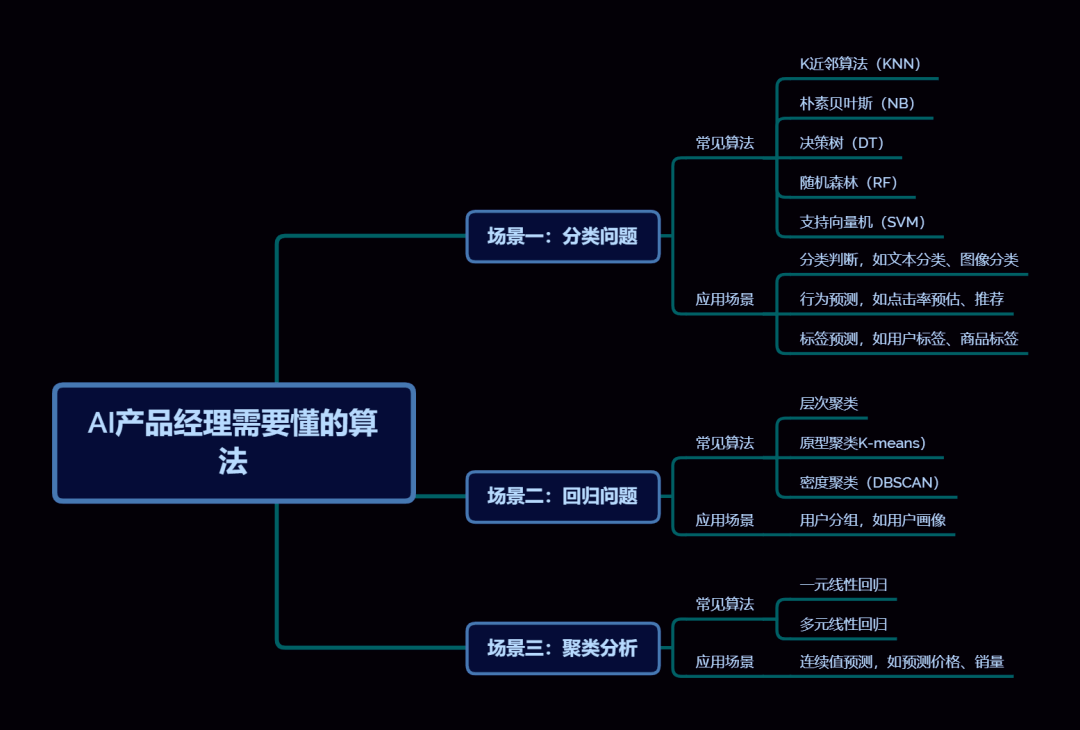
The content about interesting machine learning algorithms is the topic of the next article. This article is shared for students who are AI product managers and is highly recommended to students who have just entered this field!

We have talked before about the artificial intelligence industry, the second curve of product managers, and the differences between the two positions. This time we will go one step deeper - interesting explanations of machine learning algorithms.
Machine learning algorithms may sound a bit unfathomable. I understand that many people, including me, will have a headache at the beginning. I try not to use formulas and only present them in the form of cases. We will gradually deepen from the whole to the part.
1. Overview of machine learning algorithms
First, let’s understand the basic concepts of machine learning algorithms.
Machine learning is a method for computers to learn and improve through data, and machine learning algorithms are the tools to achieve this goal
Simply put, a machine learning algorithm is a set of rules or models that can learn based on input data and then make predictions or decisions based on the learned knowledge.
Fun Moment: Imagine you are participating in a mysterious treasure hunt. In the game, you need to find the location of the treasure based on a treasure map. This treasure map is the data, and all you have to do is find the treasure by analyzing the data. In real life, we can achieve this task through machine learning algorithms.
The machine learning algorithm is like an intelligent treasure-hunting robot that can learn patterns from a large amount of data and then make predictions or decisions based on these patterns. The core goal of machine learning algorithms is to reduce the mapping error from data to results, thereby making our products more intelligent and accurate.
The application scenarios of machine learning algorithms are very wide. Common applications include classification problems, cluster analysis and regression problems. These three application scenarios have their own applications in real life. Next, their application scenarios and practical applications will be introduced respectively

2. Scenario 1: Classification Problem
1) Application scenarios: Classification judgment, label prediction, behavior prediction.
2) Solution principle: Train the known data and predict the unknown data (including two classifications and multi-classifications. For example, the prediction result has only two discrete values, such as "0/1, yes /No" is a two-class classification. If the prediction result is multiple discrete values, such as "A/B/C", it is a multi-classification).
Common classification algorithms include the following:
4) Case: Preventing Spam
Spam filtering is a typical classification problem. We can use support vector machine algorithm to solve this problem. By training the model, we can accurately determine whether the email is spam or normal based on the keywords, sender and other information in the email
3. Scenario 2: Cluster analysis
1) Application scenarios: User grouping, user portrait
2) Solution principle: Cluster analysis is the process of dividing a set of data into several categories. These categories are based on intrinsic properties or similarities of the data. To sum up its characteristics in one word, "birds of a feather flock together".
3) Common clustering algorithms
4) Case: Customer Segmentation
For customer segmentation, it is a common cluster analysis application. We can use the K-means clustering algorithm to group customers into different categories based on their consumption amount, purchase frequency and other attributes in order to formulate precise marketing strategies
4. Scenario 3: Regression problem
1) Application scenario: Predict future prices and sales.
2) Solution principle: Fit a graph (straight line/curve) according to the distribution of the sample, form a system of equations, input parameters, and predict specific values in the future.
3) Common regression algorithms
4) Case stock price prediction
Stock price prediction is a typical regression problem. We can use linear regression or support vector machine regression algorithms to predict future stock prices based on historical stock price data.
5. Final words
To summarize, the main purpose of this article is to introduce mainstream machine learning algorithms. Next, I will analyze the algorithms of the three application scenarios one by one. If you want to know what algorithm knowledge, please share it in the comment area, welcome to create and share together
I hope it can bring you some inspiration, come on!
Please do not reprint this article. This article was originally published by @六星笑 Product on Everyone is a Product Manager without permission
The title picture comes from Unsplash, based on the CC0 protocol
The above is the detailed content of A must-read for AI product managers! A beginner's guide to getting started with machine learning algorithms. For more information, please follow other related articles on the PHP Chinese website!




